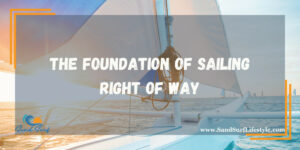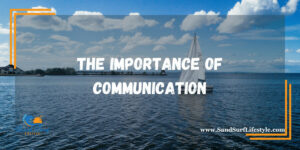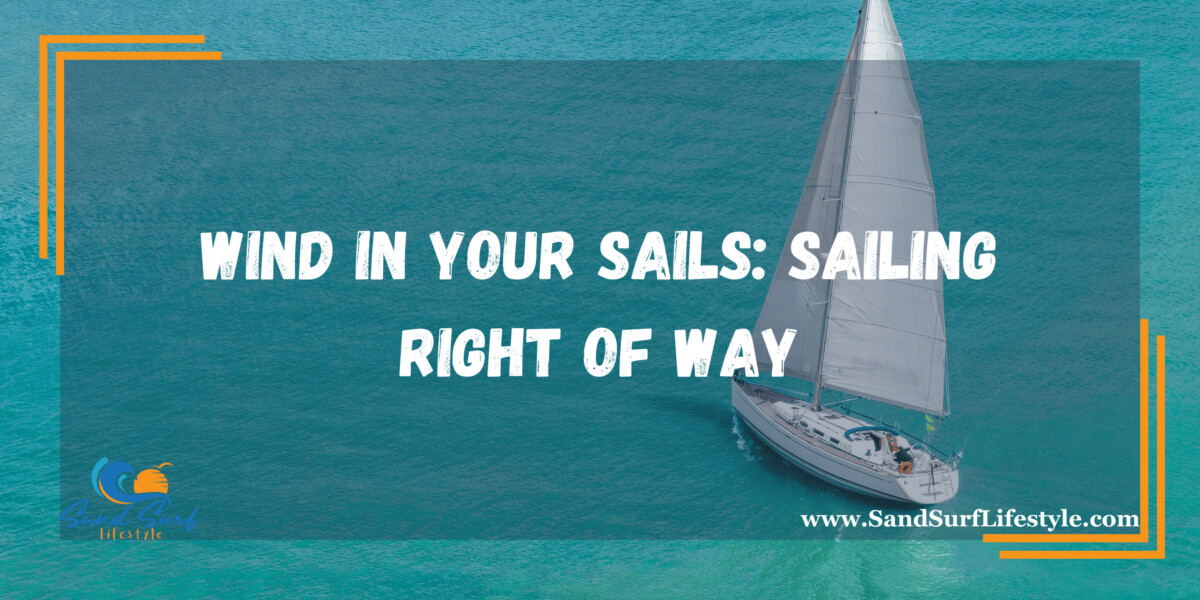Navigating the open waters on a sailboat can be an exhilarating experience, but it’s essential to understand the rules that govern the right of way. These rules, steeped in tradition and designed to ensure safety, dictate who should yield and who should stand their course when boats cross paths.
The Foundation of Sailing Right of Way

The concept of right of way in sailing serves as a fundamental cornerstone of safe and orderly navigation on the high seas. Rooted in the International Regulations for Preventing Collisions at Sea, more commonly known as COLREGs, this system of rules ensures that vessels, including sailboats, can coexist harmoniously while reducing the risk of accidents and collisions.
COLREGs, established under the auspices of the International Maritime Organization (IMO), provide a comprehensive framework that governs the behavior of vessels in various situations. While these regulations encompass a wide array of rules, a crucial subset of them is dedicated to sailing right of way. These rules are essential for sailors to grasp and implement in real-world scenarios.
The core principles underlying sailing right of way within COLREGs are designed to address three primary scenarios: head-on encounters, overtaking situations, and crossing paths at angles. By adhering to these principles, sailors can determine which vessel has the right of way and take appropriate action to prevent collisions. This adherence to right-of-way principles not only ensures safety but also contributes to the overall efficiency and harmony of maritime travel, allowing sailors to navigate the world’s waterways with confidence and responsibility.
To learn what sailing is, check out this article.
Rule 12: Sailing Vessels
Rule 12 of COLREGs specifically addresses the right of way for sailing vessels. It outlines three essential scenarios that dictate which vessel has the right of way when sailing:
- In a head-on situation, when two sailing vessels are on a collision course, the rule dictates that both boats should make a course alteration to port (left). This maneuver ensures that the vessels pass each other on the port side, maintaining safe starboard (right) side-to-starboard side clearance, thus reducing the risk of collision.
- When one sailing vessel seeks to overtake another, the overtaking vessel is considered the “give-way” vessel, and it must yield the right of way to the vessel being overtaken, referred to as the “stand-on” vessel. It is the responsibility of the overtaking vessel to maneuver safely and maintain a clear and safe distance to avoid any potential collision with the stand-on vessel.
- When sailing vessels approach each other at an angle where a risk of collision exists, the rule prescribes that the vessel having the other on its port side (left) must yield and take action to keep clear and avoid crossing ahead of the other vessel. In this scenario, the vessel on the starboard side (right) is designated as the stand-on vessel and has the right of way, allowing for a predictable and collision-free passage.
Power vs. Sail: The Hierarchy of Vessels
While sailing vessels have their right of way rules within Rule 12, there’s also a hierarchy of vessels established within COLREGs. This hierarchy helps determine the right of way in situations involving different types of vessels, including power-driven vessels.
- According to COLREGs, sailing vessels hold priority over power-driven vessels when solely under sail. This emphasizes the significance of wind propulsion in determining the right of way during sailboat encounters, prioritizing the traditional and eco-friendly means of sailing over mechanical power.
- Fishing vessels occupy a unique position in right-of-way regulations. Those engaged in active fishing, with equipment that hampers maneuverability, are granted right of way over both power-driven and sailing vessels. Nonetheless, they’re obliged to maintain their course and speed, ensuring safe passage for others navigating around them.
- Vessels not under command or constrained in maneuverability, including those with mechanical malfunctions, dredging operations, or draft limitations, are entitled to right of way over all other vessels. This rule aims to safeguard vessels experiencing difficulties and underscores the importance of giving them ample space and consideration on the water.
Understanding this hierarchy is crucial for sailors because it determines who should yield when different types of vessels encounter each other on the water.
Applying Right of Way Rules in Practical Scenarios
Now that we’ve explored the fundamental principles of sailing right of way, let’s dive into some practical scenarios to see how these rules play out on the water.
Scenario 1: Meeting Head-On
Picture yourself on a sailboat during a clear day, and you spot another sailboat directly approaching. In this head-on scenario, both vessels must adjust their course to port (left). This maneuver ensures that they pass each other on the port side, with each vessel’s starboard side (right) facing the other. This approach minimizes the risk of a collision by establishing a predictable and safe passage.
Scenario 2: Overtaking Another Sailboat
As you sail along, you notice a slower sailboat ahead, moving in the same direction. You find yourself in the role of the overtaking vessel, and the other boat becomes the stand-on vessel. In this scenario, it’s your responsibility as the overtaking vessel to keep a safe distance from the stand-on vessel. Execute a maneuver that ensures a clear path and maintains the stand-on vessel’s right of way, thereby avoiding any potential collision.
Scenario 3: Crossing Paths at an Angle
Sailing vessels frequently encounter scenarios where they approach each other at an angle. Imagine you’re sailing, and another sailboat is approaching from your right, slightly ahead. In this circumstance, the sailboat on your starboard side (right) is the stand-on vessel and has the right of way. It’s your duty to keep clear and avoid crossing ahead of the stand-on vessel, allowing for a safe and predictable passage.
Scenario 4: Interactions with Power-Driven Vessels
Now, let’s explore a situation where you’re sailing and a power-driven vessel approaches from the opposite direction. As you’re on a sailing vessel and the other vessel relies on mechanical power, you hold the right of way. The power-driven vessel should yield and make the necessary adjustments to avoid crossing your path, ensuring safe passage for both vessels.
Scenario 5: Navigating Around Fishing Vessels
When you encounter fishing vessels actively engaged in fishing operations, and their gear restricts their ability to maneuver, it’s imperative to grant them the right of way, irrespective of whether you’re on a sailing or power-driven vessel. These fishing vessels require ample space to conduct their activities safely. Therefore, it’s your responsibility to navigate around them while maintaining a safe distance, ensuring the well-being of both fishing crews and fellow mariners.
Scenario 6: Dealing with Vessels Not Under Command
In the rare event of encountering a vessel that’s not under command or significantly impaired in its ability to maneuver, possibly due to a mechanical failure, all other vessels must yield the right of way. This is a fundamental safety precaution designed to prevent collisions with vessels unable to take evasive action. Showing patience and consideration in such situations is paramount to safe navigation.
The Importance of Communication

While understanding the rules of right of way is essential, effective communication among sailors is equally vital to ensure safe navigation. Here are some communication tips to consider:
1. Use Horn Signals
Sound signals play a crucial role as a universal form of communication on the water. It’s essential for sailors to familiarize themselves with the standard horn signals designated for various situations. These signals are a means to convey intentions and warnings to other vessels when necessary, enhancing safety and coordination.
2. Visual Signals
In situations where close-quarter navigation occurs or when engines are turned off to embrace the tranquility of sailing, visual signals come to the forefront. Hand signals, waving, and other non-verbal gestures can be highly effective in communicating intentions and maintaining situational awareness, particularly when vocal communication may not be ideal.
3. VHF Radio
VHF radios are invaluable tools for maritime communication, especially in scenarios demanding immediate coordination or emergency assistance. Maintaining a functional VHF radio and having a clear understanding of its operation and proper usage is essential for effective communication with other vessels and safety at sea.
4. Navigation Lights
Navigation lights are a fundamental aspect of maritime safety, particularly during low-light conditions. Ensuring that your boat’s navigation lights are in good working order is crucial. These lights not only signal your vessel’s presence but also convey its position and course, contributing to the safety and predictability of your vessel’s movements, especially at night or in restricted visibility.
Practical Tips for Safe Sailing
In addition to understanding the rules and principles of right of way, here are some practical tips for safe sailing that every sailor should follow:
1. Maintain a Proper Lookout
Designate a vigilant lookout on board, responsible for continuously scanning the surroundings. This lookout should be watchful for other vessels and potential hazards, keeping a constant watch on the horizon to ensure early detection of any potential dangers.
2. Keep a Safe Speed
Adapt your vessel’s speed based on prevailing conditions and the presence of other watercraft. Slower speeds enhance maneuverability, offering more time to react to changing situations and reducing the risk of accidents or collisions.
3. Avoid Distractions
Maintain unwavering focus on the responsibilities of sailing and navigation. Minimize distractions, such as electronic devices, to uphold situational awareness and ensure timely responses to any emerging challenges on the water.
4. Stay Informed
Stay attuned to weather conditions and forecasts pertinent to your sailing area. Sudden weather shifts can profoundly impact your vessel’s maneuvering capabilities, making it essential to anticipate and adapt to changing conditions effectively.
5. Practice Good Seamanship
Preserve your vessel’s seaworthiness through regular maintenance routines, encompassing sails, rigging, and safety equipment. By keeping your boat in optimal working condition, you mitigate the risk of equipment failures that could compromise safety while at sea.
6. Take a Sailing Course
For those new to sailing or in need of a refresher, consider enrolling in a certified sailing course. These courses, conducted by experienced instructors, provide comprehensive instruction in safety protocols, right-of-way rules, and essential seamanship practices, equipping sailors with the knowledge and skills needed for safe and enjoyable voyages.
To learn about the optimal wind speed for sailing, check out this article.
Conclusion
Sailing offers an unparalleled sense of freedom and adventure, but it comes with responsibilities. Understanding and adhering to the principles of the right of way outlined in COLREGs is essential for safe and enjoyable sailing. By mastering these rules, communicating effectively with other sailors, and practicing good seamanship, you can navigate the waters confidently, ensuring a smooth voyage for yourself and those sharing the seas with you.
Sailing right of way is not just a set of regulations; it’s a code of conduct that ensures harmony and safety on the water. As you embark on your sailing adventures, remember that responsible and considerate sailing enriches the experience for everyone who shares your love for the open waters. So, unfurl your sails, set your course, and sail with confidence, knowing you know how to navigate any encounter, wind, or wave with grace and skill.
Please note that the contents of this blog are for informational and entertainment purposes only and should not be construed as legal advice. Any action taken based on the information provided in this blog is solely at your own risk. Additionally, all images used in this blog are generated under the CC0 license of Creative Commons, which means they are free to use for any purpose without attribution.

